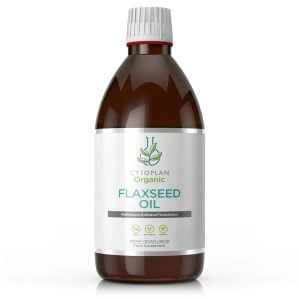
What are the Main Properties of Organic Flaxseed Oil?
Numerous studies have shown the high biological value of this product. Being a vegetable alternative to fish oil in terms of the content of unsaturated fatty acids, linseed rightfully occupies the first position among all vegetable oils. In the production of linseed oil, two technologies are used: pressing (cold or hot) and extraction. Depending on the type of processing, it is unrefined, refined, hydrated, and deodorized.
Benefits of consuming organic flaxseed oil
Flaxseed oil is so rich in omega-3s that it has given rise to the term linolenic fatty acid. The advantage of the product is in the ideal ratio of Omega-6 and Omega-3 (6:1), which determines its benefits in relation to cardiovascular, cognitive, inflammatory, and even oncological problems. Flaxseed oil is a friend of the skin, brain, and circulatory system. This is the best remedy for gastrointestinal diseases, gastritis, or liver problems.
The oil has a therapeutic effect in the treatment of type II diabetes, sclerosis, rheumatoid arthritis, asthma, eczema, psoriasis, and much other chronic and inflammatory processes.
The main properties of linseed oil when taken orally:
- Reduces cholesterol levels, protects the cardiovascular system.
- Reduces the likelihood of thrombosis in the heart, lungs, brain.
- Significantly improves the picture of asthma treatment.
- Improves digestion and gastrointestinal function, accelerates the healing of damage to the mucous membrane of the stomach and intestines, eliminates constipation.
- Normalizes liver function.
- Promotes weight loss.

How to consume linseed oil correctly?
For therapeutic purposes, you should start taking it with minimal doses of 0.5 teaspoons 2 times a day before breakfast and dinner. Then, with good tolerance, the dose is increased to 1 teaspoon 1-3 times a day, or 1-2 tablespoons on an empty stomach before meals with water.
When taken in capsules, take 2 capsules daily (morning and evening) or as directed by a physician. The duration of the treatment and preventive course is 3-4 weeks, after which you need to take a break.
It is better to clarify the dosage of the oil with the attending physician, who, based on individual data on the patient’s condition, can build the most effective and safe treatment regimen.
Flaxseed oil can be eaten both in pure form and added to salads, cereals, side dishes, mixed with kefir or yogurt.
Flaxseed oil is a superfood, the leader in the content of fatty acids and unique biologically active substances. Due to the huge health benefits and the absence of contraindications, it can be consumed by almost everyone.
Regular intake of flax oil improves digestion, acting equally favorably with constipation and diarrhea, improves the condition of the nervous system, makes blood vessels elastic, and cleanses them of harmful cholesterol. It helps with gastritis, allergies, and intoxication, normalizes blood pressure, reduces the risk of thrombosis, helps to lose weight, and has a positive effect on appearance.
Older people need to take oil to reduce the risk of cardiovascular disease, type 2 diabetes, prevent age-related changes in the brain, Alzheimer’s disease, dementia, and maintain normal cognitive functions.

Taking flaxseed oil is a simple, inexpensive, and affordable way to improve your physical and mental health, external beauty, and mood. Given the wide benefits of this product for the human body, it is worth introducing it into your daily diet. Find this supplement by visiting the Cyto Plan website.
WANT TO RECEIVE PERSONAL, STYLISH SUGGESTIONS TO YOUR EMAIL?
FILL OUT THE FOLLOWING FORM: